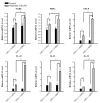Cardamonin Inhibits Oxazolone-Induced Atopic Dermatitis by the Induction of NRF2 and the Inhibition of Th2 Cytokine Production
- PMID: 32906636
- PMCID: PMC7555155
- DOI: 10.3390/antiox9090834
Cardamonin Inhibits Oxazolone-Induced Atopic Dermatitis by the Induction of NRF2 and the Inhibition of Th2 Cytokine Production
Abstract
The skin is constantly exposed to various types of chemical stresses that challenge the immune cells, leading to the activation of T cell-mediated hypersensitivity reactions including atopic dermatitis. Previous studies have demonstrated that a variety of natural compounds are effective against development of atopic dermatitis by modulating immune responses. Cardamonin is a natural compound abundantly found in cardamom spices and many other medicinal plant species. In the present study, we attempted to examine whether cardamonin could inhibit oxazolone-induced atopic dermatitis in vivo. Our results show that topical application of cardamonin onto the ear of mice suppressed oxazolone-induced inflammation in the ear and hyperplasia in the spleen. Cardamonin also inhibited oxazolone-induced destruction of connective tissues and subsequent infiltration of mast cells into the skin. In addition, we found that the production of Th2 cytokines is negatively regulated by NRF2, and the induction of NRF2 by cardamonin contributed to suppressing oxazolone-induced Th2 cytokine production and oxidative damages in vivo. Together, our results demonstrate that cardamonin is a promising natural compound, which might be effective for treatment of atopic dermatitis.
Keywords: NF-E2-related factor 2 (NRF2); T helper 2 (Th2) cytokines; cardamonin; oxazolone.
Conflict of interest statement
The authors declare no conflict of interest.
Figures






Similar articles
-
Effect of Topically Applied Wikstroemia dolichantha Diels on the Development of Atopic Dermatitis-Like Skin Symptoms in Mice.Nutrients. 2019 Apr 23;11(4):914. doi: 10.3390/nu11040914. Nutrients. 2019. PMID: 31018627 Free PMC article.
-
Panduratin A, an activator of PPAR-α/δ, suppresses the development of oxazolone-induced atopic dermatitis-like symptoms in hairless mice.Life Sci. 2014 Mar 28;100(1):45-54. doi: 10.1016/j.lfs.2014.01.076. Epub 2014 Feb 11. Life Sci. 2014. PMID: 24530874
-
Topical application of Taglisodog-eum inhibits the development of experimental atopic dermatitis.J Ethnopharmacol. 2013 Jan 30;145(2):536-46. doi: 10.1016/j.jep.2012.11.026. Epub 2012 Dec 2. J Ethnopharmacol. 2013. PMID: 23211659
-
Chemical activation of innate and specific immunity in contact dermatitis.J Invest Dermatol. 2000 Aug;115(2):168-76. doi: 10.1046/j.1523-1747.2000.00999.x. J Invest Dermatol. 2000. PMID: 10951232
-
An overview of the potential anticancer properties of cardamonin.Explor Target Antitumor Ther. 2020;1(6):413-426. doi: 10.37349/etat.2020.00026. Epub 2020 Dec 28. Explor Target Antitumor Ther. 2020. PMID: 36046386 Free PMC article. Review.
Cited by
-
Efficacy of the Radical Scavenger, Tempol, to Reduce Inflammation and Oxidative Stress in a Murine Model of Atopic Dermatitis.Antioxidants (Basel). 2023 Jun 15;12(6):1278. doi: 10.3390/antiox12061278. Antioxidants (Basel). 2023. PMID: 37372008 Free PMC article.
-
The Role of KEAP1-NRF2 System in Atopic Dermatitis and Psoriasis.Antioxidants (Basel). 2022 Jul 19;11(7):1397. doi: 10.3390/antiox11071397. Antioxidants (Basel). 2022. PMID: 35883888 Free PMC article. Review.
-
Dose-dependent effects of Nrf2 on the epidermis in chronic skin inflammation.Dis Model Mech. 2025 Jan 1;18(1):dmm052126. doi: 10.1242/dmm.052126. Epub 2025 Jan 2. Dis Model Mech. 2025. PMID: 39744884 Free PMC article.
-
Effect of Antioxidant Therapy on Oxidative Stress In Vivo.Antioxidants (Basel). 2021 Feb 25;10(3):344. doi: 10.3390/antiox10030344. Antioxidants (Basel). 2021. PMID: 33669036 Free PMC article.
-
Nrf2 Signaling Pathway in Chemoprotection and Doxorubicin Resistance: Potential Application in Drug Discovery.Antioxidants (Basel). 2021 Feb 26;10(3):349. doi: 10.3390/antiox10030349. Antioxidants (Basel). 2021. PMID: 33652780 Free PMC article. Review.
References
Grants and funding
LinkOut - more resources
Full Text Sources
Other Literature Sources

